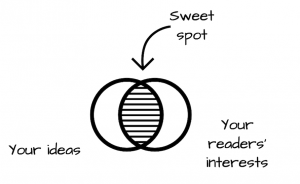 Do you want to be a better writer in the eyes of your readers? Consider investing ten minutes in a simple exercise.
Do you want to be a better writer in the eyes of your readers? Consider investing ten minutes in a simple exercise.
Although it may work for fiction, this one is designed for nonfiction writing. Try this for your next work-related or nonfiction writing project.
- Begin with a clear idea of a specific reader you want to reach. If your audience is varied, choose one representative person.
- Open an empty document, or pull out a plain sheet of paper – whatever way you can write most fluidly.
- Set a timer for ten minutes.
- In your mind, switch places with that reader and write yourself a note about the topic. Imagine any questions you might ask before and after reading the post/article/book. Keep searching for questions and ideas until the ten minutes are up.
As you fill the role of the reader, dig around for anything the reader might ask, if they had the time and inclination to be entirely honest.
For example, if you’re a marketer planning a blog post about a new feature, write yourself a note from a customer you hope to reach. By putting yourself in their shoes, you might uncover questions like:
- Wait, I haven’t used the software for three months, so exactly where does this new feature show up?
- I’m slammed until the end of the quarter. How much time will it take to learn this?
- Is this feature designed for “power users” or people like me?
- Is it worth my (limited) time to figure this out, or easier to keep doing what I’m doing now?
If you’re writing about science or technology, taking the reader’s perspective can uncover important issues such as:
- Unfamiliar terminology
- Connections between the science or technology and the reader’s life (relevance)
- Subtle resistance to change
By spending ten minutes on this exercise before writing, you may discover potential objections or areas of confusion. With those insights in advance, you can write something that better meets your audience’s needs.
Why it Works: Cognitive Empathy
By writing a letter from another person’s voice, you temporarily inhabit their perspective – and that’s the essence of cognitive empathy.
You don’t need to “feel their pain” or have a deep emotional response their situation: that’s a different response (affective empathy). It’s enough to imagine their perspective.
You don’t learn cognitive empathy in most writing classes. You practice it in real life when interacting in with the people around you. But the reader isn’t there when you write, so make an effort to take their perspective.
The effort can be as simple as writing yourself a letter.
Invest 10 minutes at the start to have a lasting impact on your readers.
The Role of Cognitive Empathy in Writing
An earlier post (How to Write Stuff People Want to Read) discussed the importance of finding the intersection between what you want to write about and what others want to read.

To draw that diagram, you need to take the readers’ perspective. Cognitive empathy helps you figure out what to write about and how much to cover. But it informs other decisions as well, including:
- Choosing examples that make sense to the readers
- Identifying unfamiliar words that add to the readers’ cognitive load
- Selecting effective stories or analogies
When writing, it’s easy to get caught up in our own words and ideas, and lose track of the reader’s perspective. Cognitive empathy is the cure.
If You Liked This…
- Read more about empathy and communication in Alan Alda’s wonderful book, If I Understood You, Would I Have This Look on My Face. Read my review here.
- Check out my latest book: Writing to Be Understood: What Works and Why